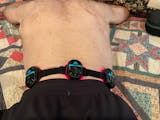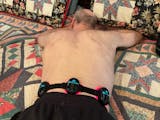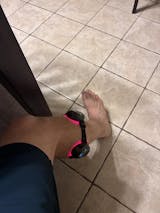In the rapidly growing field of red light therapy, numbers are everywhere: 630nm, 810nm, 830nm, and more. With so many options, it’s easy to wonder:
it’s easy to wonder: what is the best wavelength for RLT, and does it really matter?
The answer is unequivocally yes. The wavelength—which determines the light's penetration depth of the light—is the single most critical factor for therapeutic efficacy. Choosing the right one is the difference between an effective treatment and a device that simply shines a pretty light.
The PRUNGO FluxGo utilizes a specific, clinically-proven combination:
660nm Red Light and
850nm Near-Infrared (NIR) Light. This isn't an arbitrary choice.
It's a decision based on a vast body of scientific research. This guide will explain why.
The Foundation: Understanding the "Therapeutic Window"
Before diving into a 660nm vs 850nm comparison, it’s essential to understand a core concept in photobiomodulation: the "therapeutic window."
Think of human tissue as a selective filter. Some light (like UV) is harmful and blocked. Other light is absorbed by surface elements like water and blood. However, there is a specific range of wavelengths—roughly from 600nm to 900nm—that has the unique ability to bypass these blockers and penetrate deep into the body to interact with our cells. This is the therapeutic window.
Operating within this window is the bare minimum for any effective device. But for optimal results, you need to use the specific wavelengths that have been shown to be the most effective for different therapeutic goals.
The Surface Specialist: 660nm Red Light
The 660nm wavelength is at the peak of the visible red light spectrum and is arguably the most researched red light wavelength. It is characterized by its high absorption rate in skin and surface tissues.
Verdict: For anything related to skin health and surface tissue recovery, 660nm is the scientifically recognized peak wavelength for delivering targeted energy.
The Deep-Tissue Expert: 850nm Near-Infrared Light
The 850nm wavelength sits just outside the visible light spectrum in the near-infrared range. Its superpower is its ability to bypass the elements that absorb red light, allowing it to travel much deeper into the body. This is the key difference when comparing red light vs near-infrared.
-
Penetration Depth: Can reach deep into muscle, joints, tendons, and even bone.
-
Primary Benefits: This is the wavelength of choice for addressing the root cause of physical pain and deep-tissue inflammation. It's a key player in:
Verdict: For reaching the deep sources of pain and inflammation, 850nm is the gold standard wavelength for deep-tissue photobiomodulation.

The Synergy: Why the 660nm + 850nm Combination is Superior
The most effective therapy isn't an "either/or" choice; it's a comprehensive, top-to-bottom approach. This is why the
PRUNGO FluxGo's dual-light engine is so effective.
The 660nm Red Light and 850nm NIR Light work in perfect synergy. The 660nm wavelength addresses any surface-level inflammation and improves circulation, creating an ideal pathway for the 850nm wavelength to penetrate more efficiently and deliver its energy to the deep tissues. This two-pronged strategy ensures a more complete and effective therapeutic outcome.
This science translates directly into real-world results, as seen by active dad Bradley, who needed a solution for both back stiffness and a deep knee injury.
"That nagging lower back stiffness had just become something I accepted. But after two weeks with PRUNGO, that's changing... My knee specialist told me to avoid surgery and just manage my meniscus damage. After three weeks, the relief is undeniable. I'm back to hiking without that constant, dull pain."
— Bradley, Active Dad & Teacher
The Final Verdict
The choice of 660nm and 850nm wavelengths is not a trend. It's a deliberate engineering decision based on decades of scientific research identifying these two peaks as the most bio-active and effective for skin health and deep-tissue recovery. By utilizing this gold-standard combination, the PRUNGO FluxGo is designed to deliver maximum therapeutic value with every session.
Frequently Asked Questions
Q: Why not use other wavelengths like 630nm or 810nm?
A: While other wavelengths within the therapeutic window do have benefits, 660nm and 850nm are consistently cited in scientific literature as the "peaks" of efficacy for their respective targets (skin and deep tissue). The PRUNGO FluxGo uses these specific wavelengths to ensure an optimal, not just an acceptable, therapeutic response.
Q: Is one wavelength more important than the other?
A: It depends entirely on your therapeutic goal. For skin health, 660nm is key. For deep joint pain, 850nm is essential. The power of the PRUNGO FluxGo lies in its synergistic use of both, providing a comprehensive solution that other devices may not offer.





















Share:
The Science of Synergy: How Our Dual-Light Engine Works